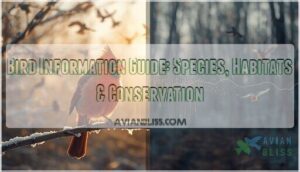This site is supported by our readers. We may earn a commission, at no cost to you, if you purchase through links.
 Migratory bird patterns are nature’s precision-engineered road trips.
Migratory bird patterns are nature’s precision-engineered road trips.
Birds, from tiny hummingbirds to majestic geese, undertake long, short, or altitudinal migrations for survival, driven by food and shelter needs.
They navigate using stars, Earth’s magnetic field, and even mountain ranges, like seasoned travelers with a built-in GPS.
These journeys often follow flyways—natural highways with “rest stops” perfect for refueling.
But human activity, climate change, and habitat loss threaten these intricate patterns, making conservation efforts essential.
Migratory birds don’t just journey for themselves—they balance ecosystems globally.
Understanding their routes reveals fascinating insights while reminding us why their protection is critical.
Table Of Contents
- Key Takeaways
- Bird Migration Basics
- Bird Navigation Methods
- Environmental Factors Impact
- Conservation Efforts Needed
- Migratory Bird Patterns
- Frequently Asked Questions (FAQs)
- What are the different types of bird migration patterns?
- What is a bird migration?
- How can I monitor bird migration patterns?
- How do migratory birds navigate?
- Are birds migratory?
- What is a migratory pattern?
- What is the flight path of migratory birds?
- What are the four flyways in North America?
- What are the formations made by certain migratory birds?
- How do migratory birds prepare for long journeys?
- Conclusion
Key Takeaways
- You’ll discover that bird migration isn’t just a journey, but a complex survival strategy involving precise navigation through celestial, magnetic, and visual cues across global ecosystems.
- You’ll see that climate change and human activities are dramatically disrupting bird migration patterns, threatening critical habitats and the delicate balance of biodiversity worldwide.
- You’ll learn that birds use multiple sophisticated navigation techniques, including star positioning, magnetic field detection, and even sense of smell, to travel thousands of miles with incredible precision.
- You’ll understand that protecting migratory birds isn’t just about saving individual species, but about maintaining interconnected global ecosystems that depend on these remarkable avian travelers.
Bird Migration Basics
You’ll find that bird migration is all about survival, with billions of birds traveling to find food and shelter.
From tiny hummingbirds to geese, each species follows unique patterns shaped by distance, season, and habitat needs.
Types of Bird Migration
Bird migration isn’t one-size-fits-all. Some adopt Nocturnal Flights, traveling under the stars, while others rely on Seasonal Shifts between breeding and wintering grounds.
Partial Migrations see certain populations stay put, while others move.
The study of bird migration patterns reveals the intricacies of these journeys. Add intriguing Nomadic Movements, where birds chase food after failed crops, and unpredictable Irruptive Patterns, making migratory bird patterns as varied as the species themselves.
Migration Routes and Flyways
Ever wonder how birds stay on track during migration? Flyways are nature’s highways, guiding birds through complex migration patterns. These routes, like the Atlantic Flyway, connect breeding and wintering grounds.
Bird corridors link habitats along these flyways, offering rest stops.
Understanding flyway variations and route mapping highlights the corridor importance, but conservation challenges threaten these delicate bird migration routes.
Importance of Bird Migration
Their long journeys aren’t just stunning; migratory bird behavior is essential for ecosystem balance.
These flights weave biodiversity into landscapes, aiding seed dispersal, pest control, and even ensuring genetic diversity.
Avian migration habits connect regions, sustaining life across bird migration routes.
Without migratory bird species, many ecosystems would collapse, revealing how bird migration patterns sustain more than just skies—they nurture Earth itself.
Bird Navigation Methods
You’d be amazed at how birds navigate with precision using the Sun, stars, Earth’s magnetic field, and even their sense of smell.
These finely tuned methods guarantee they stay on course, despite challenges like weather or unfamiliar landscapes.
Celestial Navigation
Birds are nature’s celestial navigators, using star positioning and lunar navigation to chart their way through cosmic highways. Key techniques include:
- Tracking planetary alignment for direction.
- Relying on solar cues like sunrise and sunset.
- Employing cosmic mapping to link constellations with migratory routes.
- Fine-tuning navigational patterns with seasonal changes.
Understanding Celestial Maps plays a pivotal role in deciphering these natural navigation methods.
This reliance on the stars highlights the incredible precision in migratory bird behavior.
Magnetic Orientation
Guided by Earth’s magnetic fields, birds use magnetic orientation as a built-in compass during migration.
This "bird compass" helps them align perfectly with geomagnetic guidance, even on cloudy days when celestial navigation isn’t an option.
Understanding bird migration patterns is essential for appreciating the complexity of their navigational abilities.
Scientists believe specialized molecules in their eyes detect these fields, offering a unique navigation cue that keeps migratory patterns on track despite environmental challenges.
Visual Landmarks
When birds journey across the skies, they rely on visual landmarks like mountain ranges, coastal clues, river courses, and other terrain features.
These geographic markers act as nature’s signposts, guiding migration routes along bird flyways. Think of it as traveling with a scenic map—helpful and practical.
These cues play a critical role in maintaining accurate bird migration patterns over vast distances.
Sense of Smell
Migratory birds rely on their sense of smell to read the world like a natural compass. Olfactory cues help with scent detection during avian migration, allowing birds to track odors and locate key habitats.
- Sniffing out aromatic signals to guide long flights.
- Odor tracking distinguishes safe stopovers.
- Using smell navigation for precise migration strategies.
- Scent detection mitigates disorientation risks.
Environmental Factors Impact
You’ll notice migratory birds face serious challenges when climate shifts and habitats shrink. These environmental changes disrupt their food supply, breeding sites, and travel routes.
Impact of Climate Change
Climate change throws bird migration patterns off balance.
Temperature fluctuations and weather extremes disrupt avian migration habits, forcing birds to shift their routes.
Sea level rise wipes out nesting grounds, while ecosystem disruptions confuse their natural cues.
These changes aren’t just hiccups; they’re life-altering.
Migratory birds now battle unpredictable climates, jeopardizing their survival and highlighting the cascading effects of a warming planet.
Habitat Destruction and Fragmentation
When bird habitats get chopped up or vanish, it’s like tearing apart nature’s roadmap. Habitat destruction and fragmentation lead to biodiversity decline and ecosystem disruption, stressing migratory birds.
Understanding the importance of habitat is essential for addressing these issues. Here’s how:
- Deforestation effects shrink critical nesting sites.
- Urban sprawl interrupts migration corridors.
- Agriculture replaces natural habitats.
- Pollution degrades bird-friendly zones.
- Weak wildlife preservation efforts worsen habitat loss.
Guarding habitats saves migrations.
Threats to Migratory Birds
Habitat loss, food scarcity, and climate shifts make migration a challenging marathon for birds.
Human activities like urbanization, pollution, and collisions with structures add to the chaos. Outdoor cats alone cause billions of deaths annually, while light pollution disorients them mid-journey.
These threats combine like hurdles on their migratory path, leaving them scrambling for survival. The main driver of these issues is often human impact on natural ecosystems, which disrupts delicate balances and forces birds to adapt.
| Threat | Impact | Cause |
|---|---|---|
| Habitat Loss | Reduced shelter, food, and breeding | Urbanization, farming |
| Food Scarcity | Starvation risks during migration | Climate shifts |
| Pollution Effects | Poisoning, navigation issues | Pesticides, light |
| Collisions | Millions of deaths annually | Windows, towers |
Conservation Efforts Needed
You’ve got a critical role in protecting migratory birds by supporting conservation efforts that safeguard their stopover sites and habitats.
Without these actions, species face greater risks from habitat loss, climate change, and human activity.
Protecting Stopover Sites
Stopover sites are lifelines for migratory birds, offering rest and refueling during epic journeys.
Losing these spots can disrupt bird migration patterns and threaten species.
Habitat preservation and site management are critical strategies, including establishing bird sanctuaries and wildlife refuges.
Protecting stopover locations guarantees birds complete their journeys while balancing conservation strategies with human activities to safeguard these essential habitats.
Importance of Studying Bird Migration
Understanding bird migration keeps wildlife preservation on track.
Studying migration patterns helps predict challenges like food shortages or climate shifts impacting migratory birds.
Research methods reveal how ecological balance connects global bird migrations to broader ecosystems.
Think of it as nature’s GPS, guiding ornithology research studies to protect our feathered travelers.
Bird conservation thrives when migration mysteries are solved.
International Conservation Conventions
Global agreements like the Migratory Bird Treaty Act and CMS anchor wildlife protection efforts, ensuring migratory birds have safe habitats.
These conservation laws thrive on international cooperation and environmental policies, bridging nations to tackle threats. Understanding habitat loss is essential for effective conservation strategies.
By aligning conservation biology with avian ecology, they support wildlife conservation adapted to migration routes. Together, these strategies safeguard birds, blending science with decisive action.
Migratory Bird Patterns

You may not realize it, but migratory bird patterns are like nature’s roadmap, connecting ecosystems across vast distances.
These intricate journeys, whether long or short, depend on food availability, breeding needs, and changing climates.
Long-Distance Migration
Long-distance migration is like nature’s marathon, with migratory birds crossing thousands of miles between breeding and wintering grounds.
These distance travelers rely on flight routes shaped by flyways, tracking seasonal movements for survival.
Bird tracking reveals remarkable migration patterns, like Arctic Terns flying pole-to-pole. Such migrations highlight the delicate balance of habitats sustaining these incredible journeys year after year.
Short-Distance Migration
Not all bird migration requires epic journeys.
Short-distance migration, or local bird movements, sees migratory birds managing their seasonal movements within small areas. Think of these as “daily commutes” across regional flyways for food or milder weather.
Small-scale migration showcases the adaptability of bird migration patterns, proving that even short-distance travel can shape survival and ecosystems in significant ways, influenced by milder weather.
Altitudinal Migration
Altitudinal migration lets birds shift vertically between mountain habitats, chasing food and warmth. Think of it as seasonal ascents in their migration patterns—heading higher during summer and retreating downslope with cooling weather.
These vertical movements help migratory birds find ideal nesting spots and avoid scarce resources. Understanding Altitudinal Migration patterns is essential for conservation efforts.
Bird elevations reveal fascinating patterns tied to survival and seasonal movements, proving nature’s adaptability at high altitude.
Human Population Growth
Human population growth amplifies habitat fragmentation and resource depletion, forcing birds to adapt or relocate.
Land use changes from urban expansion and human activities disrupt migration corridors and nesting sites.
Expanding agriculture and development intensify the human impact, leaving fewer safe spaces, which are affected by human activities and make it harder for birds to thrive in a world increasingly shaped by collision and constrained landscapes.
Urbanization and Development
As human expansion accelerates, urbanization and land development disrupt bird migration patterns.
City habitats replace natural ecosystems, creating habitat fragmentation that forces birds to reroute or struggle to survive. Urban planning often overlooks the environmental costs, such as diminishing stopover sites critical for rest and refueling.
The incorporation of bird friendly gardens can help mitigate these effects. The human impact leaves birds traversing a maze of buildings instead of forests, complicating their journeys.
Collision With Communication Towers
Communication towers might be invisible threats to migratory birds, but their impact isn’t small. Millions collide with them yearly, interrupting bird flyways and conservation efforts.
- Bright lights confuse birds during nighttime migration, increasing collision risks.
- Signal interference disrupts natural navigation cues, like magnetic orientation.
- Tower safety practices, like shielding lights and adjusting height, can reduce bird strikes and protect wildlife.
Frequently Asked Questions (FAQs)
What are the different types of bird migration patterns?
Birds migrate in various ways: long-distance, short-distance, latitudinal (north-south), longitudinal (east-west), altitudinal (mountain elevations), leapfrog (overlapping species), partial (some migrate, others don’t), and irregular irruptive patterns driven by food or weather changes.
The migration patterns of birds are influenced by factors such as food availability, which can be learned more about through bird migration research.
What is a bird migration?
A bird migration is nature’s ultimate road trip, where birds travel seasonally to find food, shelter, or breeding spots.
It’s all about survival, covering thousands of miles with built-in navigation systems and never-ending determination.
Understanding bird migration patterns is essential to appreciating the complexity of these journeys.
How can I monitor bird migration patterns?
You can monitor bird migration patterns using apps like eBird or BirdCast, which track real-time movements.
Try setting up light traps, recording bird calls, or watching radar maps to spot migration in action.
How do migratory birds navigate?
As if following an invisible map, migratory birds rely on the Sun, stars, Earth’s magnetic fields, and even scents to navigate.
They blend instinct, memory, and celestial cues to find their way across vast distances.
Are birds migratory?
Some birds take flight seasonally, traversing incredible distances to find food, escape harsh weather, and breed.
Around 40% of global bird species migrate, traveling from a few miles to thousands across continents.
What is a migratory pattern?
Ever feel like a bird, yearning to break free from life’s cage?
A migratory pattern is a bird’s epic journey, mapping seasonal travel routes between breeding and wintering grounds, driven by survival’s primal instincts.
What is the flight path of migratory birds?
You’ll follow specific routes called flyways, guided by the sun, stars, and Earth’s magnetic field.
Birds navigate through Pacific, Atlantic, and Central Americas Flyways, traveling thousands of miles between breeding and wintering grounds.
What are the four flyways in North America?
Soaring, traversing, exploring, and thriving—the Pacific, Central, Mississippi, and Atlantic Flyways guide North American birds.
These routes connect breeding grounds to winter havens, weaving a complex network of aerial migration paths.
What are the formations made by certain migratory birds?
When migrating, birds like geese and cranes create mesmerizing V-shaped or diagonal line formations. These aerodynamic patterns help them conserve energy, communicate, and navigate efficiently during long-distance journeys.
How do migratory birds prepare for long journeys?
You’ll fatten up, build muscle, and stash fat reserves before your epic journey.
Your body transforms, boosting metabolism and packing energy-dense nutrients to power through thousands of miles of challenging flight.
Conclusion
So, you might think tracking bird migrations is just another academic exercise, but it’s far more critical.
By understanding migratory bird patterns, we’re not just studying nature—we’re protecting global ecosystems.
Climate change threatens these incredible journeys, making conservation urgent.
You can help by supporting habitat preservation, participating in citizen science projects, and spreading awareness.
Every action counts in ensuring these remarkable avian travelers continue their timeless migrations, maintaining the delicate balance of our planet’s biodiversity.












